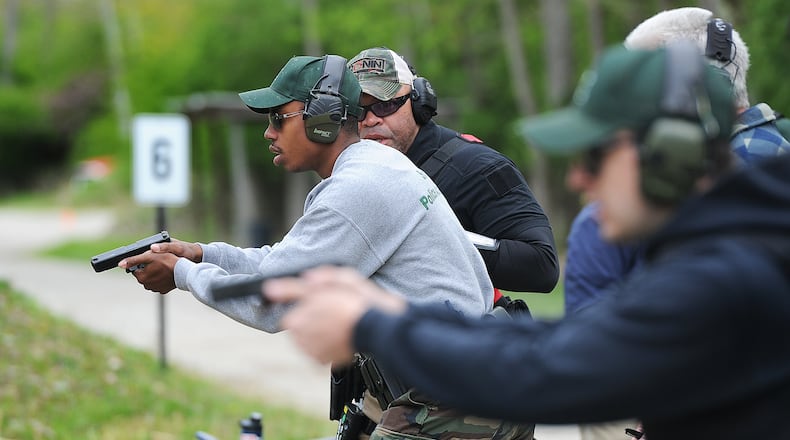“All of you are about to get a lot worse,” said academy firearms instructor Eric Totel.
He was right. A quirk in human psychology leads someone unused to firing guns to do far worse with their second shot than their first, as they begin to anticipate the small explosion happening in their hands, and flinch the rest of the body accordingly.
The next four shots for most people on the line were a smattering of perforations around the paper target.
For three crisp April weeks, Sinclair Police Academy cadets went out to a remote facility operated by the Montgomery County Sheriff’s Office for one of the most anticipated training sections of the year: firearms.
The Montgomery County Sheriff’s Randal K. Richter Memorial Firearms Training Facility in Dayton hosts police departments from across Montgomery County and beyond for training and practice. But for three weeks, the 19 cadets, some of whom have never touched a gun before in their lives, would qualify on handgun, shotgun and patrol rifle.
Between the 19 of them and over the course of three weeks, cadets shot about $6,000 worth of ammunition.
By the end of the first day, cadet Sam Niyomurezi said he knew what he had to work on, but was much more confident than the first time he shot.
“When I pulled that trigger for the first time I was scared. The second time I just started relaxing and then take it easy on myself. Doing it for the first time, it was also a cool experience,” he said.
Credit: JIM NOELKER
Credit: JIM NOELKER
Basic firearm safety is paramount even prior to day one: Treat all firearms as if they’re loaded. Keep your finger off the trigger until you’ve made a conscious decision to shoot. If you drop your gun or mag, leave it and wait for the range master to come get it. They’ll make fun of you and then give it back.
Cadets are taught to be aware of the backstop of what they’re shooting at, and beyond. For example, if you’re aiming at a target and your backstop is drywall, you have to consider what could be behind the drywall: The bullet will not stop there.
Mastering handgun is a matter of mastering fundamentals. Your shooting platform starts with your feet: slightly offset, weight slightly on the front of the foot. Unholster in a smooth motion, bringing the gun to the center of the chest.
Rather than “scooping” the muzzle from the ground up, “push” the gun straight from center mass out to eye level, so that you are able to easily find your sights. Aim, make a conscious decision to shoot, and pull straight back on the trigger.
Then, breathe and look around. When the heart rate is up, the human body tends to go into tunnel vision. Lower the muzzle enough to scan and check for other threats. Check the condition of yourselves, your weapon, and your fellow officers, and reluctantly re-holster.
Mastering these fundamentals will make a good marksman more than anything else.
“The secret to hitting a pie plate at 1,000 yards is repetition,” Totel told cadets.
Shooting sports is an expensive hobby, but practicing marksmanship doesn’t have to be, instructors said. Practicing the above flow on a regular basis, as a cooldown for the day, as well as dry-firing the weapon, reduces the chance of complacency, and thus someone getting hurt.
Qualifying on the basic state-mandated firearm requirements really isn’t that difficult, said Totel, who told cadets he doesn’t believe in simply “teaching to the test.”
“Most of the time we spend here isn’t spent working on the state qualification,” Totel said. “Our goal is to get the cadets qualified within the first several days, so we can work on actually training some more tactically advantageous and beneficial items for them that they can work on as far as moving and shooting, multiple targets, and target identification, and things that are going to be super beneficial to them when they hit the streets.”
Cadets shoot in two relays. While the other relay shoots, the off relay talks, snacks, or scrolls social media. One day, Chol Chol, a cadet from South Sudan, teaches us how to write our names in Arabic.
By the end of the three weeks of range, cadets are able to move and shoot accurately, up to 30 feet. The very last day, the class competes to see who can be Top Gun in handgun and shotgun. The afternoon is then spent cooking out, and cadets are able to bring their own firearms to shoot. This last bit allows the cadets to handle and fire all different kinds of guns, and is beneficial because the public expects officers to know how to handle them.
“It was tough for my parents to hear I was going to be carrying a gun,” Niyomurezi said. “But it’s part of the job. I would say a gun is going to be my last option. It’s only for a deadly force position, I don’t see myself using it. For me, my best weapon is my voice.”
About the Author



